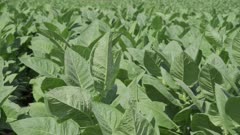
Plants in the Solanaceae can take the form of herbs, shrubs, trees, vines and lianas, and sometimes epiphytes. They can be annuals, biennials, or perennials, upright or decumbent. Some have subterranean tubers. They do not have laticifers, nor latex, nor coloured saps. They can have a basal or terminal group of leaves or neither of these types. The leaves are generally alternate or alternate to opposed (that is, alternate at the base of the plant and opposed towards the inflorescence). The leaves can be herbaceous, leathery, or transformed into spines. The leaves are generally petiolate or subsessile, rarely sessile. They are frequently inodorous, but on occasions, they are aromatic or fetid. The foliar lamina can be either simple or compound, and the latter can be either pinnatifid or ternate. The leaves have reticulated venation and lack a basal meristem. The laminae are generally dorsiventral and lack secretory cavities. The stomata are generally confined to one of a leaf's two sides they are rarely found on both sides. The flowers are generally hermaphrodites, although some are monoecious, andromonoecious, or dioecious species (such as some Solanum or Symonanthus). Pollination is entomophilous. The flowers can be solitary or grouped into terminal, cymose, or axillary inflorescences. The flowers are medium-sized, fragrant (Nicotiana), fetid (Anthocercis), or inodorous. The flowers are usually actinomorphic, slightly zygomorphic, or markedly zygomorphic (for ex... Learn more about Nightshade
View all family groups for: Plant
Nightshade Species Videos
View All Nightshade Videos
Common Name | Scientific Name | Conservation Status |
Angel Trumpet (3 videos) | Acleisanthes longiflora | Not Available |
Belladonna (6 videos) | Atropa bella-donna | Not Available |
Black Nightshade (1 videos) | Solanum nigrum | Not Available |
Eggplant (11 videos) | Solanum melongena | Not Available |
Garden Tomato (1 videos) | Solanum lycopersicum | Not Available |
Nightshade (1 videos) | Solanum macrocarpon | Not Available |
Tobacco (26 videos) | Nicotiana tomentosa | Not Available |
